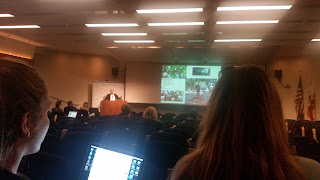Event 4- Intersex
For this 4th event, I went to a talk on intersex and listened to Dr. Georgiann Davis from UNLV and Dr. Vernon Rosario from UCLA. This was interesting because I do not know much about intersex. Intersex, according to insa.org is, “variety of conditions in which a person is born with a reproductive or sexual anatomy that doesn’t seem to fit the typical definitions of female or male” (insa.org). This would be like someone born with a male appearance, but having female anatomy.
 |
| (Sign at the Event) |
Dr. Davis is very knowledgeable on this topic as she has written many works on intersex. Some of the things she mentioned are:
- It is hard to mark
- This makes sense because how will the parent know what gender the baby is and feels?
- The parent should not have to make the choice for the child
- If the child is born intersex, they should have the choice to choose later
- It is a slower process for transexual people as they need to prove
- A transgender person is someone who simply feels like the other gender that was marked. There is not much difference, yet they have a slower process to go through
- Finally, she wanted doctors and providers to collaborate
Dr. Rosario gave a brief history on intersex and used some artwork in his powerpoint that depicted intersex. Some of his main points were:
- These are fairly new terms
- Maybe prior to this, it was taboo to claim you were different than the gender assigned. There were definitely people earlier who had a tough time being intersex or not heterosexual.
- Hermaphroditism was the base of medical knowledge
- Hermaphroditism is someone born with both reproductive organs
- This makes sense that this would be the foundation for doctors, as they would be seeing that the person has both. Whereas in intersex, the person may feel a different gender and that is almost impossible for doctors to spot

(Dr. Rosario's presentation)
This does seem like something I may consider to write the final on. Before going to this talk I did not realize that there were all these problems with gender and being assigned at birth. This now does open my eyes a bit more to realize that this is an important problem- people are being assigned the wrong gender at birth or not given the choice to pick. I agree with Dr. Davis that the process for intersex should be slow and that collaboration is key!
 |
| (selfie of me by the sign) |
Sources
"What Is Intersex?" What Is Intersex? | Intersex Society of North America. Insa.org, n.d. Web. 9
June 2017.
Selfie with sign in the back. Photograph. Mine
Sign at the Door. Photograph. Mine
Dr. Davis’s Powerpoint. Photograph. Mine
Dr. Rosario’s Powerpoint. Photograph. Mine



Comments
Post a Comment